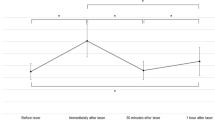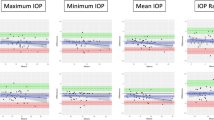Abstract
Background
The changes of blood pressure in patients undergoing cataract procedure are not well studied. The blood pressures of cataract patients often become uncontrolled intraoperatively causing the procedure to be postponed. Intraoperative rise in blood pressure has been associated with ocular complications such as suprachoroidal haemorrhage and can be fatal from stroke or even myocardial infarction. We attempt to study the changes in blood pressure of patients undergoing cataract surgery.
Aim
Prospective study on the variation of blood pressure pre- and intra-operatively.
Method
The blood pressure readings of patients going for cataract procedures were measured in five stages during the pre-assessment clinic, on arrival at the day surgery, at the anaesthetic room, on the operating table intraoperatively; and postoperatively. The readings were compared to their age, sex, past medical history, and use of antihypertensive medication.
Results
The rise in systolic blood pressures between intraoperative readings and those at the preassessment and anaesthetic room was highly statistically significant.
Being older (>65 years of age), taking more than two antihypertensive drugs, being hypertensive, or having a family history of hypertension does not appear to increase the risk.
Conclusion
Our study showed that there is a significant rise in systolic blood pressures especially in females during topical phacoemulsification. Further studies are needed on the factors that determine this increase and the changes in blood pressures during different stages of the procedure.
Similar content being viewed by others
Background
Phacoemulsification under topical anaesthesia has advantages over local or general anaesthesia. These include avoidance of complications related to general anaesthesia, reduced theatre time for patients, and efficient usage of the operating room. However, the rise in blood pressures during phacoemulsification has been questioned by the surgeon and the anaesthetist who would like the procedure to be safer. Possible causes of increased blood pressure can include discomfort and pain from the microscope light, iris manipulation, phacoemulsification, irrigation, aspiration, and intraocular lens implantation.1 Apart from life-threatening events such as myocardial infarctions or strokes, uncontrolled blood pressures can lead to suprachoroidal haemorrhage2 and even retinal vascular occlusion intraoperatively.
Variation of blood pressures may depend on the patient's state of health, age, surgical techniques, and the surgeon's skills. In one study, Suzuki et al3 reported an increase in the preoperative blood pressure and a decrease in the postoperative levels. In another study on 39 patients, 19 of them showed a 20% or greater increase in systolic arterial pressure measured intraoperatively.4 Our study investigated the effect of phacoemulsification under topical anaesthesia on the blood pressures.
Method
Fifty-five patients listed for elective cataract surgery during the period from February 2007 to May 2007 were recruited for the study. They were first seen during preassessment 2 weeks before their cataract surgery. Their blood pressures were checked together with questions asked regarding their general health and medications taken.
Informed consents were taken from the patients on participation for the blood pressures study.
Patients requiring general anaesthetic or regional blocks such as peri-bulbar or subtenons were excluded from the study. Patients found to have excessively high blood pressures on the day of operation and those needing antihypertensive intervention intraoperatively were also excluded from the study.
Five blood pressure readings were taken from the patient in total: (1) in the preassessment clinic 2 weeks before, (2) on arrival on the day of surgery, before installation of dilating drops, (3) in the anaesthetic room before surgery, (4) intraoperatively, and (5) postoperatively 30 min after transfer to the recovery ward.
The blood pressures were measured at the upper extremity with a blood pressure cuff at a height equal to the level of the patient's heart. They were taken after the patients have been in a sitting position for 5 min with automated blood pressure instruments. All blood pressure readings were taken with the patients sitting up except when the patients were in the anaesthetic room and intraoperatively, when they were supine.
Dilating medications used include 2.5% phenylephrine, 1% tropicamide, and Ocufen. Topical anaesthetics used include 1 ml of 0.5% proxymethocaine 5 min before the procedure. If the patient complained of pain, appeared anxious, or squeezed on the lid speculum, an additional 0.3–0.5 ml of 0.5% proxymetacaine was given. The patients were not given premedication orally or intravenously.
Phacoemulsifications were performed by two consultants in the unit. Intraoperatively, the blood pressures were measured every 5 min and the highest readings were recorded. A portion of 0.5 mg of 1 in 1000 adrenaline was added to 500 ml of balance salt solution for further dilation of the pupil during phacoemulsification.
Oxygen supply at 2 l min−1 was provided to the patient under the drape. Intracameral vancomycin was given postoperatively and the wounds were hydrosealed with no suture used.
Postoperatively, the patients were rested at the waiting area for at least 30 min before their blood pressure readings were taken.
Results were analysed using Window Excel 2007 and SPSS 15.0 (SPSS Inc., Chicago, IL, USA) to ensure data quality.
Results
Of the 55 patients, 7 were excluded from the study, as we could not complete all five readings. Fourty-six (83.6%) patients completed the study protocol and could be included in the blood pressure analysis. Six (13.0%) patients were below 65 years while 40 (87.0%) were above the age of 65 (median=80 years, range 41–91 years). There were 19 males (41.3%) and 27 females (58.7%). Twenty-seven (58.7%) of the patients were hypertensive while six (13.0%) had a family history of hypertension.
Comparing the paired t-test results on the different settings, the rise of systolic blood pressures measured intraoperatively and at the preassessment and anaesthetic room was highly statistically significant. The increase in diastolic blood pressures between preassessment and intraoperatively was statistically significant. There was a 14.78% rise in systolic blood pressures and an increase of 7.43% in diastolic blood pressures between the intraoperative and preassessment readings.
On comparison between the gender, females had a higher risk of rise in systolic blood pressures and this was moderate and statistically significant (P=0.07).
No significant change was found in both the systolic and diastolic blood pressures between the two groups of patients. Being older (>65 years of age), taking more than two antihypertensive medicines, or having a family history of hypertension does not appear to increase the risk.
Discussion
The increase in blood pressure intraoperatively was thought to be a response to pain. Fichman asked 600 of his cataract patients who underwent topical anaesthesia to rate their level of discomfort during surgery. Eighty per cent of them reported having mild discomfort, 8% moderate, and 3% severe pain. He also monitored the blood pressure of 100 patients and only 1% of them had raised blood pressure.5
There is an increased risk of 2.13 times of having cataract extraction in hypertensive patients, especially those between 60 and 69 years of age compared with non-hypertensives as reported in one study.6 However, being hypertensive does not seem to be a risk for rise in blood pressure in this study.
The concentration of phenylephrine used for our cataract patients was 2.5%. Kenawy et al7 reported some increase of both systolic and diastolic blood pressures in patients who had phenylephrine with concentration of 10% instilled compared to 2.5% but the increase was not statistically significant. Malhotra et al8 and Symons et al9 reported no change in the blood pressures between the two different concentrations of phenylephrine.
Limitations of the study include the small number of patients recruited with blood pressure measurements taken by five different ambulatory machines in different positions. The highest blood pressure readings were recorded intraoperatively and it is not known which phacoemulsification steps was done during the rise in blood pressure. It would be good to include monitoring of the blood pressure during different stages of the procedure with the involvement of more patients in future studies
Variability in responses may be due to blood pressures measurements taken at different stages intraoperatively. They also reflect the range in response of blood pressures between individuals during cataract surgery. Understanding the variation of blood pressures intraoperatively and identification of at-risk patients will help to make procedure safer (Figure 1; Tables 1, 2, 3, and 4).
References
Patel BC, Burns TA, Crandall A, Shomaker ST, Pace NL, van Eerd A et al. A comparison of topical and retrobulbar anesthesia for cataract surgery. Ophthalmology 1996; 103 (8): 1196–1203.
Ling R, Cole M, James C, Kamalarajah S, Foot B, Shaw S . Suprachoroidal haemorrhage complicating cataract surgery in the UK: epidemiology, clinical features, management, and outcomes. Br J Ophthalmol 2004; 88 (4): 478–480.
Suzuki R, Kuroki S, Fujiwara N, Umemoto S . The effects of phacoemulsification cataract surgery via local anesthesia on preoperative and postoperative blood pressure levels. Ophthalmology 1997; 104 (2): 216–222.
Mamiya K, Manabe M, Aono J, Ueno H . Blood pressure control during eye surgery under local anaesthesia using pulse oximetry. Ophthalmologica 1998; 212 (4): 236–238.
Fichman RA . Use of topical anesthesia alone in cataract surgery. J Cataract Refract Surg 1996; 22 (5): 612–614.
Szmyd Jr L, Schwartz B . Association of systemic hypertension and diabetes mellitus with cataract extraction. A case–control study. Ophthalmology 1989; 96 (8): 1248–1252.
Kenawy NB, Jabir M . Phenylephrine 2.5% and 10% in phacoemulsification under topical anaesthesia: is there an effect on systemic blood pressure? Br J Ophthalmol 2003; 87 (4): 505–506.
Malhotra R, Banerjee G, Brampton W, Price NC . Comparison of the cardiovascular effects of 2.5% phenylephrine and 10% phenylephrine during ophthalmic surgery. Eye 1998; 12 (Part 6): 973–975.
Symons RC, Walland MJ, Kaufman DV . A comparative study of the efficacy of 2.5% phenylephrine and 10% phenylephrine in pre-operative mydriasis for routine cataract surgery. Eye 1997; 11 (Part 6): 946–948.
Author information
Authors and Affiliations
Corresponding author
Rights and permissions
About this article
Cite this article
Yap, Y., Woo, W., Kathirgamanathan, T. et al. Variation of blood pressure during topical phacoemulsification. Eye 23, 416–420 (2009). https://doi.org/10.1038/sj.eye.6703006
Received:
Revised:
Accepted:
Published:
Issue Date:
DOI: https://doi.org/10.1038/sj.eye.6703006
This article is cited by
-
Early intervention for perioperative hypertension in cataract surgery
Graefe's Archive for Clinical and Experimental Ophthalmology (2023)




